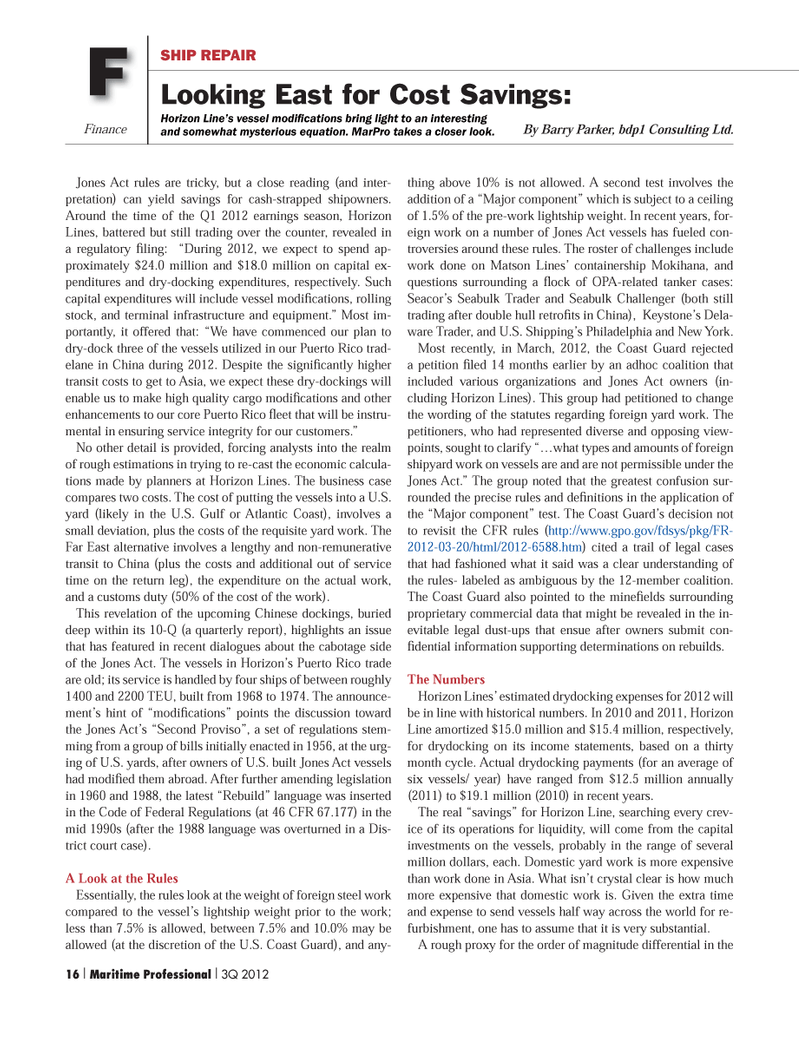
Page 16: of Maritime Logistics Professional Magazine (Q3 2012)
Classification Societies, Quality & Design
Read this page in Pdf, Flash or Html5 edition of Q3 2012 Maritime Logistics Professional Magazine
Jones Act rules are tricky, but a close reading (and inter- pretation) can yield savings for cash-strapped shipowners. Around the time of the Q1 2012 earnings season, Horizon Lines, battered but still trading over the counter, revealed in a regulatory Þ ling: ÒDuring 2012, we expect to spend ap- proximately $24.0 million and $18.0 million on capital ex- penditures and dry-docking expenditures, respectively. Such capital expenditures will include vessel modiÞ cations, rolling stock, and terminal infrastructure and equipment.Ó Most im- portantly, it offered that: ÒWe have commenced our plan to dry-dock three of the vessels utilized in our Puerto Rico trad- elane in China during 2012. Despite the signiÞ cantly higher transit costs to get to Asia, we expect these dry-dockings will enable us to make high quality cargo modiÞ cations and other enhancements to our core Puerto Rico ß eet that will be instru- mental in ensuring service integrity for our customers.Ó No other detail is provided, forcing analysts into the realm of rough estimations in trying to re-cast the economic calcula-tions made by planners at Horizon Lines. The business case compares two costs. The cost of putting the vessels into a U.S. yard (likely in the U.S. Gulf or Atlantic Coast), involves a small deviation, plus the costs of the requisite yard work. The Far East alternative involves a lengthy and non-remunerative transit to China (plus the costs and additional out of service time on the return leg), the expenditure on the actual work, and a customs duty (50% of the cost of the work). This revelation of the upcoming Chinese dockings, buried deep within its 10-Q (a quarterly report), highlights an issue that has featured in recent dialogues about the cabotage side of the Jones Act. The vessels in HorizonÕs Puerto Rico trade are old; its service is handled by four ships of between roughly 1400 and 2200 TEU, built from 1968 to 1974. The announce- mentÕs hint of ÒmodiÞ cationsÓ points the discussion toward the Jones ActÕs ÒSecond ProvisoÓ, a set of regulations stem- ming from a group of bills initially enacted in 1956, at the urg- ing of U.S. yards, after owners of U.S. built Jones Act vessels had modiÞ ed them abroad. After further amending legislation in 1960 and 1988, the latest ÒRebuildÓ language was inserted in the Code of Federal Regulations (at 46 CFR 67.177) in the mid 1990s (after the 1988 language was overturned in a Dis- trict court case). A Look at the RulesEssentially, the rules look at the weight of foreign steel work compared to the vesselÕs lightship weight prior to the work; less than 7.5% is allowed, between 7.5% and 10.0% may be allowed (at the discretion of the U.S. Coast Guard), and any- thing above 10% is not allowed. A second test involves the addition of a ÒMajor componentÓ which is subject to a ceiling of 1.5% of the pre-work lightship weight. In recent years, for- eign work on a number of Jones Act vessels has fueled con- troversies around these rules. The roster of challenges include work done on Matson LinesÕ containership Mokihana, and questions surrounding a ß ock of OPA-related tanker cases: SeacorÕs Seabulk Trader and Seabulk Challenger (both still trading after double hull retroÞ ts in China), KeystoneÕs Dela- ware Trader, and U.S. ShippingÕs Philadelphia and New York. Most recently, in March, 2012, the Coast Guard rejected a petition Þ led 14 months earlier by an adhoc coalition that included various organizations and Jones Act owners (in- cluding Horizon Lines). This group had petitioned to change the wording of the statutes regarding foreign yard work. The petitioners, who had represented diverse and opposing view- points, sought to clarify ÒÉwhat types and amounts of foreign shipyard work on vessels are and are not permissible under the Jones Act.Ó The group noted that the greatest confusion sur- rounded the precise rules and deÞ nitions in the application of the ÒMajor componentÓ test. The Coast GuardÕs decision not to revisit the CFR rules ( http://www.gpo.gov/fdsys/pkg/FR- 2012-03-20/html/2012-6588.htm) cited a trail of legal cases that had fashioned what it said was a clear understanding of the rules- labeled as ambiguous by the 12-member coalition. The Coast Guard also pointed to the mineÞ elds surrounding proprietary commercial data that might be revealed in the in- evitable legal dust-ups that ensue after owners submit con- Þ dential information supporting determinations on rebuilds. The NumbersHorizon LinesÕ estimated drydocking expenses for 2012 will be in line with historical numbers. In 2010 and 2011, Horizon Line amortized $15.0 million and $15.4 million, respectively, for drydocking on its income statements, based on a thirty month cycle. Actual drydocking payments (for an average of six vessels/ year) have ranged from $12.5 million annually (2011) to $19.1 million (2010) in recent years.The real ÒsavingsÓ for Horizon Line, searching every crev- ice of its operations for liquidity, will come from the capital investments on the vessels, probably in the range of several million dollars, each. Domestic yard work is more expensive than work done in Asia. What isnÕt crystal clear is how much more expensive that domestic work is. Given the extra time and expense to send vessels half way across the world for re- furbishment, one has to assume that it is very substantial. A rough proxy for the order of magnitude differential in the Finance SHIP REPAIR Looking East for Cost Savings:Horizon Line?s vessel modi Þ cations bring light to an interesting and somewhat mysterious equation. MarPro takes a closer look. FBy Barry Parker, bdp1 Consulting Ltd. 16 I Maritime Professional I 3Q 2012MP #3 1-17.indd 16MP #3 1-17.indd 168/14/2012 5:04:53 PM8/14/2012 5:04:53 PM

 15
15

 17
17
